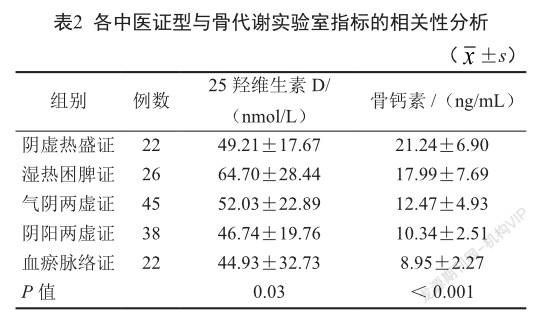2型糖尿病中医证型与糖、骨代谢主要实验室指标的相关性研究
2021-12-05浦莉俊
浦莉俊



摘 要 目的:為研究2型糖尿病患者中医证型与糖、骨代谢主要实验室指标的相关性,为早期发现及早干预2型糖尿病合并骨质疏松提供一定的理论依据。方法:收集2019年至2020年上海市普陀区甘泉街道社区卫生服务中心门诊收治的2型糖尿病患者153例,完成临床症状归纳表,收集患者基本资料、病史、四诊信息进行辨证分型,同时检测、分析血清胰岛素、C肽、25羟维生素D、骨钙素等糖、骨代谢实验室检测指标,了解2型糖尿病的中医证型分布规律及特点。运用单因素方差分析的统计方法,研究中医辨证分型与糖、骨代谢主要实验室指标的相关性。结果:153例2型糖尿病患者5种中医证型间比较,空腹C肽、餐后2 h C肽、25羟维生素D、骨钙素与中医证型之间有相关性(P<0.05);空腹胰岛素及餐后2 h胰岛素与中医证型之间无相关性(P>0.05)。结论:2型糖尿病中医证型的演变规律为阴虚热盛证-湿热困脾证-气阴两虚证-阴阳两虚血瘀水停证-血瘀脉络证。血清C肽和25羟维生素D可反映中医证型的动态变化,与中医证型之间存在一定的相关性。
关键词 2型糖尿病;中医证型;糖代谢;骨代谢;实验室指标
中图分类号:R58 文献标志码:A 文章编号:1006-1533(2021)22-0038-03
Correlation study between TCM syndrome types and main laboratory indexes of glucose and bone metabolism in type 2 diabetes mellitus
PU Lijun(Traditional Chinese Medicine Department of Ganquan Community Health Service Center of Putuo District, Shanghai 200062, China)
ABSTRACT Objective: To study the correlation between TCM syndrome types and main laboratory indexes of glucose and bone metabolism in patients with type 2 diabetes mellitus, to provide a theoretical basis for early detection and early intervention of type 2 diabetes mellitus combined with osteoporosis. Methods: One hundred and fifty-three patients with type 2 diabetes mellitus admitted to the outpatient clinic of the Community Health Service Center in Ganquan Community, Putuo District, Shanghai from 2019 to 2020 were collected, the clinical symptom induction table was completed, the patients basic data, medical history and four diagnosis information for syndrome differentiation were collected, at the same time, the laboratory test indexes of glucose and bone metabolism such as serum insulin, C peptide, 25 hydroxyvitamin D and osteocalcin were detected and analyzed to understand the distribution pattern and characteristics of TCM syndromes of type 2 diabetes mellitus. The statistical method of one-way ANOVA was used to study the correlation between TCM syndrome differentiation and the main laboratory indexes of glucose and bone metabolism. Results: Compared with the 5 TCM syndromes of 153 patients with type 2 diabetes mellitus, there was a correlation between fasting C peptide, postprandial 2 h C peptide, 25 hydroxyvitamin D, osteocalcin and TCM syndrome types(P<0.05); there was no correlation between fasting insulin and 2 h postprandial insulin and TCM syndrome types(P>0.05). Conclusion: The evolution pattern of TCM syndromes of type 2 diabetes mellitus is Yin deficiency heat accumulation syndrome - dampness heat dampness spleen syndrome - Qi Yin two deficiency syndrome - Yin and Yang two deficiency, blood stasis and water stop syndrome - blood stasis syndrome. serum C peptide and 25 hydroxyvitamin D can reflect the dynamic changes of TCM syndrome types, and there is a certain correlation with TCM syndrome types.
KEY WORDS type 2 diabetes mellitus; TCM syndrome; glucose metabolism; bone metabolism; laboratory index
糖尿病(Diabetes mellitus,DM)是一种慢性代谢性疾病,其最突出特征为持续性血糖浓度偏高。随着年龄和病程的增加,2型糖尿病(T2DM)患者慢性并发症的发生率逐渐提升[1]。由于DM并发症早期隐匿性很强,常常在出现并发症后才得到诊断[2]。T2DM患者是发生骨质疏松症的高危人群。骨质疏松症(Osteoporosis,OP)是一种中老年人群的常见病,以骨量减少、骨微结构破坏、骨强度下降、骨脆性增加、骨折风险增大等为特点[3]。T2DM合并OP患者的昂贵医疗费用带来了沉重的经济负担,也会影响患者生活质量。对T2DM患者主要生化指标进行定期观察能够较好地预防DM及其并发症的发生[4]。因此,探索T2DM中医证型与糖代谢、骨代谢相关实验室检查的研究逐渐成为目前研究的热点。
1 资料与方法
1.1 一般资料
收集2019年至2020年上海市普陀区甘泉街道社区卫生服务中心门诊收治的T2DM病人153例,均符合1999年WHO糖尿病诊断标准[5],且同时符合2002年《中药新药临床研究指导原则(试行)》中医辨证分型标准[6],中医辨证时各证型主症符合2条及以上兼有次症,且舌苔或脉象相符即辨为是证,有阴虚热盛证、湿热困脾证、气阴两虚证、阴阳两虚血瘀水停证、血瘀脉络证5种证型。其中阴虚热盛证患者22例,男性12例,女性10例,平均年龄(56.77±11.46)岁,平均病程(5.91±4.85)年;湿热困脾证患者26例,男性14例,女性12例,平均年龄(63.96±11.27)岁,平均病程(8.58±5.81)年;气阴两虚证患者45例,男性28例,女性17例,平均年龄(64.42±10.57)岁,平均病程(9.73±5.95)年;陰阳两虚,血瘀水停证患者38例,男性18例,女性20例,平均年龄(69.74±10.17)岁,平均病程(14.34±5.63)年;血瘀脉络证患者22例,男性13例,女性9例,平均年龄(69.77±7.87)岁,平均病程(16.05±5.22)年。各组间一般资料比较差异无统计学意义(P>0.05)。所有患者签署知情同意协议书。排除:1型糖尿病患者,有垂体、甲状腺、甲状旁腺、肾上腺等内分泌疾患者,有软骨病等代谢性疾患者,有严重心、肝、肾、造血系统疾患及功能衰竭者,有严重感染、酮症等糖尿病急性并发症者,患者病情复杂、难以归为上述任一中医证型者。
1.2 方法
采用统一印制的T2DM临床信息调查记录表,登记患者的临床信息,主要内容包括四诊结果、实验室指标结果(胰岛素、C肽、25羟维生素D、骨钙素等)。患者就诊后立即进行症候问卷调查。症候选项由患者在医师指导下自行填写,体征由研究人员记录。根据中医证型诊断标准分析并最终辨证分型。所有患者先禁食12 h,次日早晨8:00空腹抽取肘静脉血,采用化学发光免疫分析法检测空腹血清胰岛素、C肽水平,酶联免疫法ELISA检测25羟维生素D,酶联免疫吸附法检测骨钙素。
1.3 统计学分析

2 结果
2.1 T2DM中医证型与糖代谢实验室指标的相关性
五组中医证型的空腹C肽均值从高到低依次为阴虚热盛证、气阴两虚证、阴阳两虚证、血瘀脉络证、湿热困脾证,经方差分析比较发现空腹C肽值与中医证型之间有相关性(P<0.05)。其中,阴虚热盛证与湿热困脾证之间比较P=0.006,阴虚热盛证与阴阳两虚证之间比较P=0.016,阴虚热盛证与血瘀脉络证之间比较P=0.021,湿热困脾证与气阴两虚证之间比较P=0.016,气阴两虚证与阴阳两虚证之间比较P=0.042,余组两两比较差异无统计学意义(P>0.05)。五组中医证型的餐后2 h C肽均值从高到低依次为阴虚热盛证、气阴两虚证、湿热困脾证、阴阳两虚证、血瘀脉络证,经方差分析比较发现餐后2 h C肽值与中医证型之间有相关性(P<0.05)。其中,阴虚热盛证与湿热困脾证之间比较P=0.045,阴虚热盛证与气阴两虚证之间比较P=0.027,阴虚热盛证与阴阳两虚证之间比较P=0.001,阴虚热盛证与血瘀脉络证之间比较P=0.001,余组两两比较差异无统计学意义(P>0.05)。见表1。
空腹胰岛素水平与中医证型之间无相关性(P>0.05);且两两组间比较差异亦无统计学意义(P>0.05)。餐后2 h胰岛素水平与中医证型之间无相关性(P>0.05),且两两组间比较差异亦无统计学意义(P>0.05)。见表1。

2.2 T2DM中医证型与骨代谢实验室指标的相关性
五组中医证型的25羟维生素D均值从高到低依次为湿热困脾证、气阴两虚证、阴虚热盛证、阴阳两虚证、血瘀脉络证,25羟维生素D值与中医证型之间有相关性(P<0.05)。其中,阴虚热盛证与湿热困脾证之间比较P=0.029,湿热困脾证与气阴两虚证之间比较P=0.035,湿热困脾证与阴阳两虚证之间比较P=0.004,湿热困脾证与血瘀脉络证之间比较P=0.005;余组两两间比较差异无统计学意义(P>0.05)。见表2。

